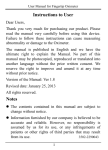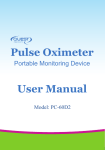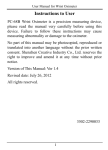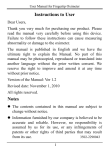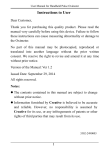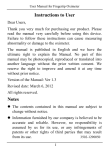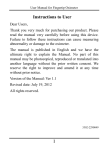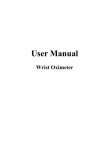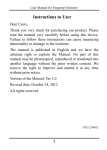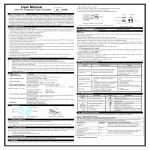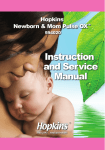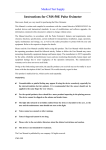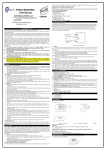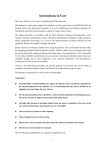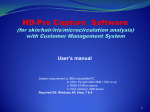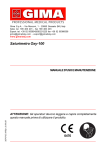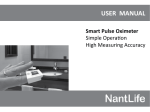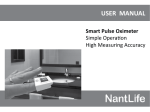Download Instructions to Users
Transcript
User Manual for Fingertip Oximeter Instructions to User Dear Users, Thank you very much for purchasing our product. Please read the manual very carefully before using this device. Failure to follow these instructions may cause measuring abnormality or equipment damage. The Manual is published in English and we have the ultimate right to explain the Manual. No part of this manual may be photocopied, reproduced or translated into another language without the prior written consent. We reserve the right to improve and amend it at any time without prior notice. Version of This Manual: Ver 1.1 Revised date: Feb. 17, 2012 All rights reserved. 3502-2290046 I User Manual for Fingertip Oximeter Notes: The contents contained in this manual are subject to change without notice. Information furnished by our company is believed to be accurate and reliable. However, no responsibility is assumed by us for its use, or any infringements of patents or other rights of third parties that may result from its use. Instructions for Safe Operations Check the device to make sure that there is no visible damage that may affect user’s safety or measurement performance with regard to sensors and clips. It is recommended that the device should be inspected minimally once a week. When there is obvious damage, stop using the device. Necessary maintenance must be performed only by qualified service technicians. Users are not permitted to maintain it by themselves. The oximeter cannot be used together II User Manual for Fingertip Oximeter with devices not specified in User Manual. Cautions Explosive hazard—DO NOT use the oximeter in environment with inflammable gas such as some ignitable anesthetic agents. DO NOT use the oximeter while the testee is under MRI or CT scanning. Warnings An uncomfortable or painful feeling may appear if using the oximeter continuously on the same place for a long time, especially for poor microcirculation patients. It is recommended that the oximeter should not be applied to the same location for longer than 2 hours. If any abnormal condition is found, please change the position of oximeter. DO NOT clip this device on edema or tender tissue. The light (the infrared light is invisible) emitted from the device is harmful to the III User Manual for Fingertip Oximeter eyes, so service technician or testee should not stare at the light. The local law must be followed when disposing of the device. Attentions Keep the oximeter away from dust, vibration, corrosive substances, explosive materials, high temperature and moisture. The device should be kept out of the reach of children. If the oximeter gets wet, please stop using it and do not resume operation until it is dry. When it is carried from a cold environment to a warm and humid environment, please do not use it immediately. DO NOT operate the button on the front panel with sharp materials. DO NOT use high temperature or high pressure steam disinfection on the oximeter. Refer to Chapter 7 for instructions of cleaning and disinfection. IV User Manual for Fingertip Oximeter Declaration of Conformity: The manufacturer hereby declares that this device complies with the following standards: IEC 60601-1 ISO 9919 and follows the provisions of the council directive MDD93/42/EEC. V User Manual for Fingertip Oximeter Table of Contents 1 OVERVIEW ......................................................... 1 1.1 Appearance .................................................. 1 1.2 Features ........................................................ 2 1.3 Name.............................................................. 2 1.4 Applications and Scope ............................ 2 2 BATTERY INSTALLATION ............................... 3 3 OPERATION........................................................ 4 4 INSTRUCTIONS FOR OPERATION ................ 6 5 TECHNICAL SPECIFICATIONS ...................... 7 6 ACCESSORIES ................................................ 10 7 REPAIR AND MAINTENANCE....................... 11 7.1 Maintenance............................................... 11 7.2 Cleaning and Disinfecting Instruction . 12 8 TROUBLESHOOTING ..................................... 13 APPENDIX ............................................................ 14 Key of Symbols ............................................... 14 Common Knowledge ...................................... 15 VI User Manual for Fingertip Oximeter 1 Overview 1.1 Appearance Rubber Cushions Display Key Display Screen Figure 1 Front View Battery Cover Nameplate Hanging Hole Figure 2 Rear View -1- User Manual for Fingertip Oximeter 1.2 Features The Fingertip Oximeter can be used to measure pulse oxygen saturation (SpO2) value and pulse rate value (PR). Simply put your finger into sensor and press the start button, SpO2 value and pulse rate value will be displayed on screen. It is lightweight, small in size and easy to carry; Large bright LCD; Accurately measure SpO2 value and pulse rate value; Automatically start measuring after putting finger into rubber cushions; Power off automatically without signal for less than 5 seconds; Visible alarm function; Low voltage indication; 1.3 Name Name: Fingertip Oximeter 1.4 Applications and Scope Fingertip Oximeter is intended for measuring the -2- User Manual for Fingertip Oximeter pulse rate and functional oxygen saturation (SpO2) through patient’s finger. It is applicable for spot-checking SpO2 and pulse rates of adult and pediatric patients in home and clinics. 2 Battery Installation Figure 3 Battery Installation 1. Refer to Figure 3, insert two AAA size batteries into the battery compartment properly in the right direction. 2. Replace the cover. Please take care when you insert the batteries, or the improper insertion may make the device not work. -3- User Manual for Fingertip Oximeter 3 Operation 1. Open the clip as shown in Figure 4. Figure 4 Put Finger into the Sensor 2. Put finger into the rubber cushions of the clip (make sure the finger is in the right position), and then clip the finger; 3. The device will power on automatically in 2 seconds and start to measure. 4. Measurement result will be displayed on the screen (as shown in Figure 5). User can read SpO2 and HR values from display screen. “%SpO2”: SpO2 symbol “ ”: Pulse beat icon; “BPM”: the unit of pulse rate (beats per minute); “ ”: Bargraph for pulsatile indication. -4- User Manual for Fingertip Oximeter Figure 5 Figure 6 5. Change display direction. Two directions display alternately. Press Display Key once at a time, display screen will be flipped 180° each time in a cyclic manner. See Figure 6. 6. Alarm Indicator When measuring, if SpO2 value or pulse rate value exceeds the preset alarm limit, the value which exceeds limit on the screen will flash (refer to Technical Specifications for alarm limits). -5- User Manual for Fingertip Oximeter 4 Instructions for Operation The finger should be put in properly and correctly. Do not shake the finger and keep at ease during using. Do not put wet finger directly into sensor. Avoid placing the device on the same limb which is wrapped with a cuff for blood pressure measurement or during venous infusion. Do not let anything block the emitting light from device. Vigorous exercise and electrosurgical device interference may affect the measuring accuracy. Using enamel or other makeup on the nail may affect the accuracy of measurement. If the first reading is unlikely true, the more stable value is expected by waiting for a while, or a restart is needed when necessary. -6- User Manual for Fingertip Oximeter 5 Technical Specifications A. Display mode:LCD Display B. Power supply requirement: 2 x LR03 (AAA) alkaline batteries Supply voltage: 3.0VDC Operating current: ≤40mA C. SpO2 Measurement Transducer: dual-wavelength LED Measurement wavelength: Red light: 663 nm, Infrared light: 890 nm. Maximal optical output power: less than 1.5mW maximum average Measuring range: 35~99% Measuring accuracy: Not greater than 3% for SpO2 range from 70% to 100% *NOTE: Accuracy defined as root-mean-square value of deviation according to ISO 9919. D. Pulse Rate Measurement Measuring range: 30bpm~240bpm -7- User Manual for Fingertip Oximeter Accuracy: ±2bpm or ±2% (whichever is greater) E. Preset alarm limits SpO2 alarm: Lower limit: 90% Pulse Rate alarm: Upper limit: 120bpm Lower limit: 50bpm F. Update rate: 8 beats moving average for Pulse Rate and SpO2 readings. G. Environment requirement Operating Temperature: 5°C ~40°C Operating Humidity: 30%~80% Atmospheric pressure: 70kPa~106kPa H. The performance under low perfusion condition The accuracy of SpO2 and PR measurement still meet the precision described above when the modulation amplitude is as low as 0.6%. I. Resistance to interference of surrounding light: The difference between the value measured in the condition of indoor natural light and that of darkroom is less than ±1%. -8- User Manual for Fingertip Oximeter J. Resistance to 50Hz /60Hz interference: SpO2 and PR are precise which have been tested by SpO2 simulator from Fluke Biomedical Inc. K. Dimensions: 60mm (L)*33mm (W)*30mm (H) Gross Weight: 60g (including batteries) L. Classification The type of protection against electric shock: Internally powered equipment. The degree of protection against electric shock: Type BF applied parts. The degree of protection against harmful ingress of liquids: Ordinary equipment without protection against ingress of water. Electro-Magnetic Compatibility: Group I, Class B -9- User Manual for Fingertip Oximeter 6 Accessories A. A lanyard B. Two batteries C. A pouch D. A User Manual E. Quality Certificate Note: The accessories are subject to change. Detailed items and quantity see the Packing List. -10- User Manual for Fingertip Oximeter 7 Repair and Maintenance 7.1 Maintenance The service life (not a warranty) of this device is 5 years. In order to ensure its long service life, please pay attention to the use of maintenance. A. Please change the batteries when the low-voltage indicator lightens. B. Please clean the surface of the device before using. Wipe the device with alcohol first, and then let it dry in air or wipe it dry. C. Please take out the batteries if the oximeter will not be used for a long time. D. The recommended storage environment of the device: ambient temperature: -20ºC ~60ºC, relative humidity 10%~95%, atmospheric pressure: 50kPa~107.4kPa. E. The oximeter is calibrated in the factory before sale, there is no need to calibrate it during its life cycle. However, if it is necessary to verify its accuracy routinely, the user can do the verification by means of SpO2 simulator, or it can -11- User Manual for Fingertip Oximeter be done by the local third party test house. High-pressure sterilization cannot be used on the device. Do not immerse the device in liquid. It is recommended that the device should be kept in a dry environment. Humidity may reduce the life of the device, or even damage it. 7.2 Cleaning and Disinfecting Instruction A. Surface-clean sensor with a soft gauze by saturating with a solution such as 75% isopropyl alcohol, if low-level disinfection is required, use a 1:10 bleach solution. B. Then surface-clean with clean water and dry with a piece of cloth. Caution: Do not sterilize by irradiation steam, or ethylene oxide. Do not use the sensor if it is damaged. -12- User Manual for Fingertip Oximeter 8 Troubleshooting Trouble The SpO2 and Pulse Rate display instable Possible Reason 1. The finger is not placed far enough inside. 2. The finger is shaking or the patient is moving. The device can not turn on 1. The batteries are drained or almost drained. 2. The batteries are not inserted properly. 3. The device is malfunction. The indicator light is off suddenly 1. The device will power off automatically when it gets no signal for 8 seconds. 2. The batteries are almost drained. -13- Solution 1. Place the finger correctly inside and try again. 2. Let the patient keep calm 1. Change batteries. 2. Reinstall batteries. 3. Please contact the local service center. 1. Normal. 2. Change batteries. User Manual for Fingertip Oximeter Appendix Key of Symbols Symbol Description With Type BF applied part Warning ─ See User Manual The pulse oxygen saturation Pulse rate (beats per minute) Low battery voltage Serial number Disposal of this device according to WEEE regulations -14- User Manual for Fingertip Oximeter Common Knowledge 1 Meaning of SpO2 SpO2 is the saturation percentage of oxygen in the blood, so called O2 concentration in the blood; it is defined by the percentage of oxyhemoglobin (HbO2) in the total hemoglobin of the arterial blood. SpO2 is an important physiological parameter to reflect the respiration function; it is calculated by the following method: SpO2 = HbO2/ (HbO2 +Hb)×100% HbO2 are the oxyhemoglobins (oxygenized hemoglobin), Hb are those hemoglobins which release oxygen. 2 Principle of Measurement Based on Lamber-Beer law, the light absorbance of a given substance is directly proportional with its density or concentration. When the light with certain wavelength emits on human tissue, the measured intensity of light after absorption, reflecting and attenuation in tissue can reflect the structure -15- User Manual for Fingertip Oximeter character of the tissue by which the light passes. Due to that oxygenated hemoglobin (HbO2) and deoxygenated hemoglobin (Hb) have different absorption character in the spectrum range from red to infrared light (600nm~1000nm wavelength), by using these characteristics, SpO2 can be determined. SpO2 measured by this oximeter is the functional oxygen saturation -- a percentage of the hemoglobin that can transport oxygen. In contrast, hemoximeters report fractional oxygen saturation – a percentage of all measured hemoglobin, including dysfunctional hemoglobin, such as carboxyhemoglobin or metahemoglobin Clinical application of pulse oximeters: SpO2 is an important physiological parameter to reflect the respiration and ventilation function, so SpO2 monitoring used in treatment has become more popular. (For example, such as monitoring patients with serious respiratory disease, patients under anesthesia during operation and premature and neonatal infants) The status of SpO2 can be determined in timely manner by measurement and -16- User Manual for Fingertip Oximeter will allow finding the hypoxemia patient earlier, thereby preventing or reducing accidental death caused by hypoxia effectively. 3 Factors affecting SpO2 measuring accuracy (interference reason) Intravascular dyes such as indocyanine green or methylene blue Exposure to excessive illumination, such as surgical lamps, bilirubin lamps, fluorescent lights, infrared heating lamps, or direct sunlight. Vascular dyes or external used color-up product such as nail enamel or color skin care Excessive patient movement Placement of a sensor on an extremity with a blood pressure cuff, arterial catheter, or intravascular line Exposure to the chamber with High pressure oxygen There is an arterial occlusion proximal to the -17- User Manual for Fingertip Oximeter sensor Blood vessel contraction caused by peripheral vessel hyperkinesias or body temperature decreasing 4 Factors causing low SpO2 Measuring value (pathology reason) Hypoxemia disease, functional lack of HbO2 Pigmentation or abnormal oxyhemoglobin level Abnormal oxyhemoglobin variation Methemoglobin disease Sulfhemoglobinemia exists near sensor or arterial occlusion Obvious venous pulsations Peripheral arterial pulsation becomes weak Peripheral blood supply is not enough -18- User Manual for Fingertip Oximeter -19-



























